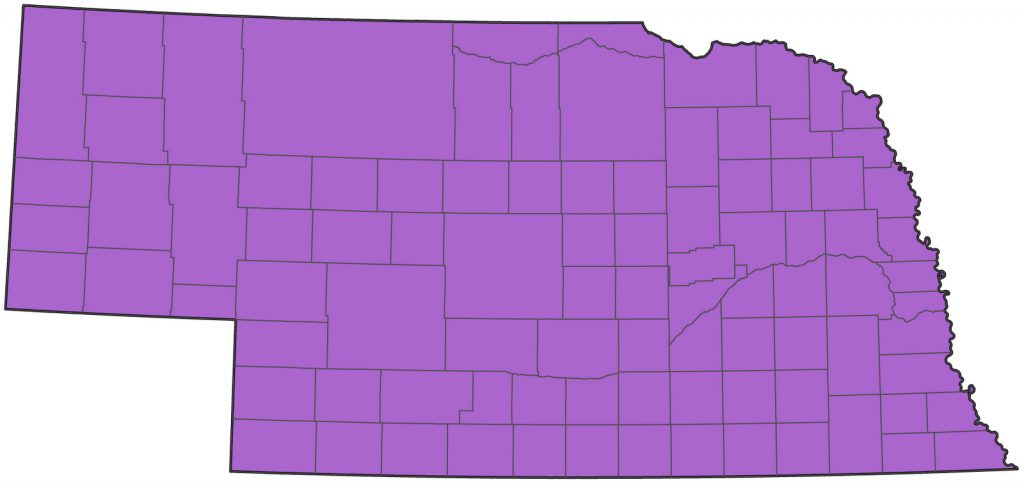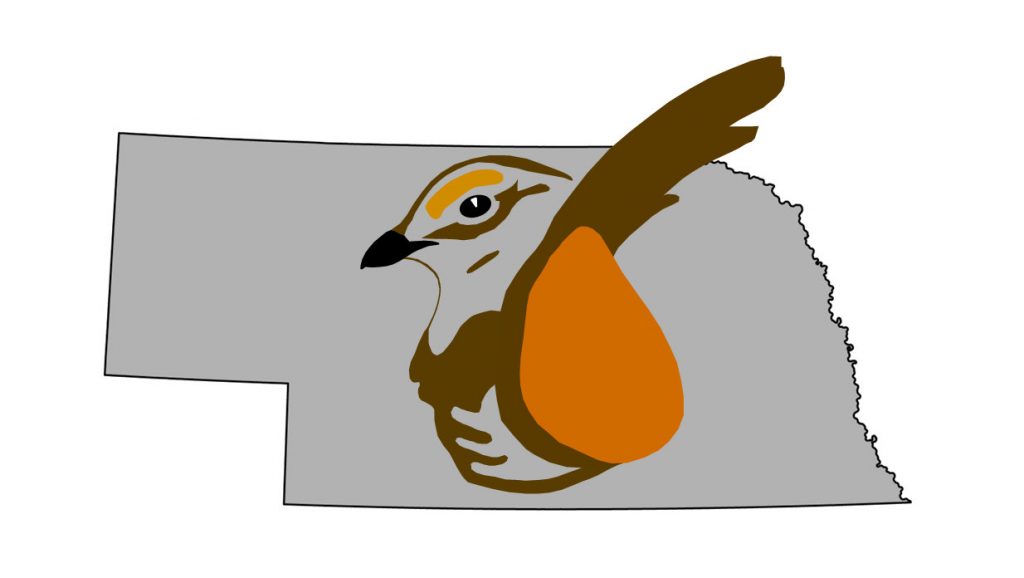Dryobates pubescens medianus, D. p. leucurus
Status: Common regular resident east and central, fairly common west.

Documentation: Specimen: UNSM ZM12374, 25 Nov 1893 Lancaster Co.
Taxonomy: There have been several recent changes in generic assignment of woodpeckers. Genus Dryobates includes species previously assigned to genera Dendrocopos and Picoides, including Nuttall’s, Ladder-backed, and Downy Woodpeckers of North America and Crimson-crested and Lesser Spotted Woodpeckers of Eurasia (Fuchs and Pons 2015, Chesser et al 2018).
There are seven subspecies of Downy Woodpecker (Gill et al 2022): fumidus, gairdnerii, and turati of the Coastal Pacific, glacialis and leucurus of the Interior West, and medianus and pubescens in the Eastern US.
In Nebraska, two subspecies occur; eastern medianus breeding over most of the state, and the Rocky Mountain subspecies leucurus, possibly breeding in the extreme northwest (Haecker et al 1945), although there is no current evidence to support more than occasional visitor status. Subspecies medianus has spread westward in Nebraska during the 20th century in river valleys (see Resident, below) and is currently commonly reported westward to Wyoming and Colorado in the North Platte and South Platte river valleys (eBird.org, accessed Oct 2023). This westward shift of medianus has resulted in occasional contact with leucurus; Ford collected an intermediate specimen (KU 34088) five miles north of Harrison, Sioux Co on 18 Jul 1957 (Ford 1959), and an “intermediate” was at Sowbelly Canyon, Sioux Co 26 May 2021. A leucurus was studied at Fort Robinson SP, Dawes Co 18 May 2018; it was with an apparent medianus. Medianus and leucurus are identifiable in the field; leucurus has little or no white spotting on the greater wing-coverts (“shoulders”) and less black in its outer rectrices (Jackson and Ouellet 2020).
Subspecies leucurus may also be a winter disperser or vagrant in low numbers from the Rocky Mountains to Nebraska; it occurs rarely in winter on the eastern plains of Colorado (Andrews and Righter 1992) and at Barr Lake, Colorado Oct to mid-May where local breeders are medianus (Andrews et al 2002). There are three reports of leucurus for Nebraska: two were at Fort Robinson SP, Dawes Co 18 May 2018, one paired with an eastern medianus; two were photographed at Exit 1 on Interstate 80, Kimball Co 19 Nov 2019; and one was in Carter Canyon, Scotts Buff Co 29 Dec 2023. An alternative explanation for occurrence of leucurus Downy Woodpeckers on the eastern Colorado plains was suggested by Jackson and Ouellet (2020): dispersal may occur in concert with migrations of other species. Of about 35 records on the eastern plains of Colorado, 18 are for Mar-May and nine for Nov-Dec (17 for Sep-Feb), and only one for Jun-Aug (eBird.org, accessed Oct 2023).
Intriguing was the appearance in three consecutive winters of a Downy Woodpecker with a yellow (rather than red) nape in a Scotts Bluff Co yard Feb and fall of 2010, Mar 2011, and 24-25 Nov 2012 (Ann Duey, personal communication). It had minimal white markings on its shoulders, suggesting Rocky Mountain provenance. According to Jackson and Ouellet (2020), “males occasionally grow a yellowish (not red) nape- or forehead-patch”.
This species and Hairy Woodpecker are known to hybridize on rare occasions. See Hybrids – Birds of Nebraska – Online (outdoornebraska.gov).
Resident: BBS data indicate highest numbers in the east, with numbers very low in the west. Bruner et al (1904) considered this species very common in the eastern third of Nebraska around 1900, but rare and local in the western half of the state. Ducey (1988) shows no breeding records in the central prior to 1920.
- Breeding Phenology:
Eggs: 4 May- 15 Jun (Mollhoff 2022)
Nestlings: 15 May-2 Jul
Fledglings 14 May- 11 Jul - High Counts: 28 at Glenn Cunningham Lake, Douglas Co 14 Dec 2023, 25 at Fontenelle Forest, Sarpy Co 2 Apr 2010, 23 there 27 Sep 2023, 21 at Glenn Cunningham Lake 8 Jan 2022, and 21 in a Sarpy Co yard 29 Oct 2022.
Winter distribution resembles that in summer, according to CBC data. Bent (1939) and Browning (1995) noted that there is little or no evidence for movement of Downy Woodpeckers, although some low density wandering into Nebraska of leucurus may occur in the west (see Taxonomy); Rosche (1982) considered Downy Woodpecker more common in the northwest in winter than in summer.
Highest CBC counts include 191 at Omaha in 1977-78 and 175 there in 1981-82. Highest CBC counts in the west are 29 at Crawford in 1977-78 and 20 at Scottsbluff in 1976-77.
Abbreviations
BBS: Breeding Bird Survey
CBC: Christmas Bird Count
SP: State Park
UNSM: University of Nebraska State Museum
Literature Cited
Andrews, R., and R. Righter. 1992. Colorado birds. Denver Museum of Natural History, Denver, Colorado, USA.
Andrews, R., R. Righter, M. Carter, T. Leukering, and A. Banks. 2002. Birds of Barr Lake and Surrounding Areas 1888 through 1999. An Annotated Checklist. Rocky Mountain Bird Observatory Ornithological Monograph.
Bent, A.C. 1939. Life histories of North American woodpeckers. Bulletin of the United States National Museum 174. Dover Publications Reprint 1964, New York, New York, USA.
Browning, M.R. 1995. Do Downy Woodpeckers migrate? Journal of Field Ornithology 66: 12-24.
Bruner, L., R.H. Wolcott, and M.H. Swenk. 1904. A preliminary review of the birds of Nebraska, with synopses. Klopp and Bartlett, Omaha, Nebraska, USA.
Chesser, R.T., K.J. Burns, C. Cicero, J.L. Dunn, A.W. Kratter, I.J. Lovette, P.C. Rasmussen, J. V. Remsen, Jr., D.F. Stotz, B.M. Winger, and K. Winker. 2018. Fifty-ninth Supplement to the American Ornithological Society’s Check-list of North American Birds. Auk 135: 798-813.
Ducey, J.E. 1988. Nebraska birds, breeding status and distribution. Simmons-Boardman Books, Omaha, Nebraska, USA.
Ford, N.L. 1959. Notes on summer birds of western Nebraska. NBR 27: 6-12.
Fuchs, J., and J-M. Pons. 2015. A new classification of the Pied Woodpeckers assemblage (Dendropicini, Picidae) based on a comprehensive multi-locus phylogeny. Molecular Phylogenetics and Evolution 88: 28-37. https://doi.org/10.1016/j.ympev.2015.03.016.
Gill, F., D. Donsker, and P. Rasmussen (Eds). 2022. IOC World Bird List (v 12.2). Doi 10.14344/IOC.ML.12.2. http://www.worldbirdnames.org/.
Haecker, F.W., R.A. Moser, and J.B. Swenk. 1945. Checklist of the birds of Nebraska. NBR 13: 1-40.
Jackson, J.A. and H.R. Ouellet. 2020. Downy Woodpecker (Dryobates pubescens), version 1.0. In Birds of the World (P. G. Rodewald, Editor). Cornell Lab of Ornithology, Ithaca, NY, USA. https://doi.org/10.2173/bow.dowwoo.01.
Mollhoff, W.J. 2022. Nest records of Nebraska birds. Nebraska Ornithologists’ Union Occasional Paper Number 9.
Rosche, R.C. 1982. Birds of northwestern Nebraska and southwestern South Dakota, an annotated checklist. Cottonwood Press, Crawford, Nebraska, USA.
Recommended Citation
Silcock, W.R., and J.G. Jorgensen. 2024. Downy Woodpecker (Dryobates pubescens). In Birds of Nebraska — Online. www.BirdsofNebraska.org
Birds of Nebraska – Online
Updated 4 Jul 2024
